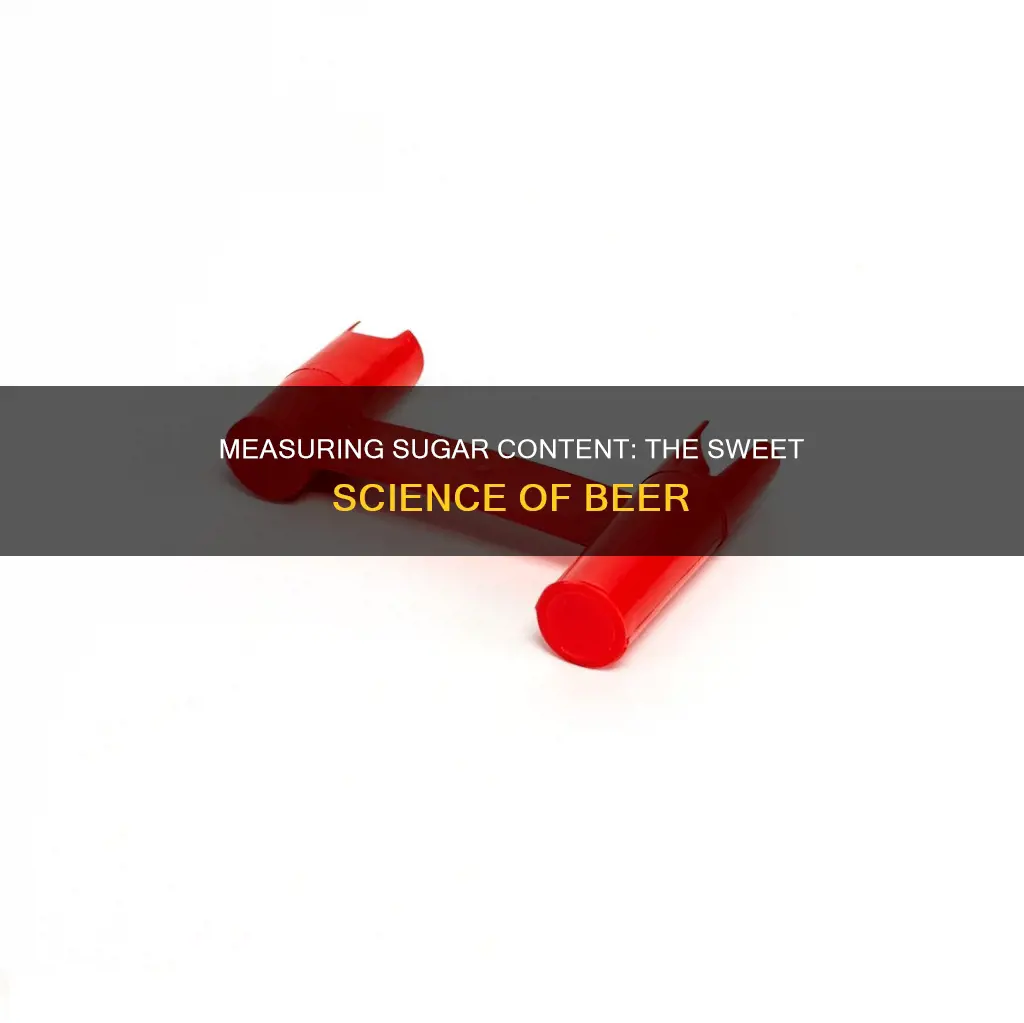
The sugar content in beer can be measured in a few different ways. One way is to use a hydrometer, which calculates the sugar level by measuring the relative density of the liquid. Another method is to use a refractometer, which determines the Brix value by measuring the refraction of light passing through a liquid sample. The Brix value indicates the number of grams of sucrose present per 100 grams of liquid and can be used to calculate the approximate potential alcohol content. Additionally, the sugar content in beer can be measured through the distillation process by distilling a sample of beer and then measuring the Brix value of the remaining content.
| Characteristics | Values |
|---|---|
| What is being measured | Sugar content in beer |
| Why measure sugar content | To calculate the approximate potential alcohol content |
| How to measure sugar content | Using a refractometer or a hydrometer |
| What is a refractometer | An instrument that determines the Brix value by measuring the refraction of light passing through a liquid sample |
| What is a hydrometer | An instrument that calculates a liquid's sugar level by measuring its relative density |
| What is the Brix value | The number of grams of sucrose present per 100 grams of liquid |
| How to calculate potential alcohol content | Multiply the Brix value by 0.59 |
| What is specific gravity | A measure of the specific gravity (SG) of the wort at 20°C |
| What is the real degree of fermentation | A measurement of the percentage of the original gravity that was actually fermented, adjusted for alcohol content |
What You'll Learn

Using a hydrometer
Step 1: Prepare the Hydrometer and Trial Jar
Clean and sterilise the hydrometer and the trial jar, which is used to hold the beer sample. Rinse them in warm water and then sterilise using a suitable sanitising solution. Finally, rinse them thoroughly. This step is crucial to prevent unwanted bugs from spoiling your beer.
Step 2: Draw the Beer Sample
Place some beer from your brew into the sterilised trial jar. Use a pipette, syphon tube, or any sterile tool to draw the sample. Ensure you put in enough beer so that the hydrometer will float without overflowing.
Step 3: Take the Original Gravity Reading
Gently lower the hydrometer into the trial jar. Spin the hydrometer to eliminate any air bubbles and ensure it is not sticking to the sides. Wait for it to settle, then take the reading. The reading will be at the point where the underside of the beer's surface meets the scale on the hydrometer. Note down this reading, as it indicates the amount of sugar in your beer.
Step 4: Calculate Alcohol Content
To determine the alcohol content, you need both the original gravity (OG) and the final gravity (FG) readings. The formula to calculate alcohol by volume (ABV) is:
ABV(%) = (OG - FG) * 131.25
So, if your original gravity reading is 1.054, and your final gravity reading is 1.015, your ABV would be:
1.054 - 1.015) * 131.25 = 5.12%
Additional Tips:
- It is recommended to take the OG reading after the boil, once the wort has cooled, and before pitching the yeast.
- For the FG reading, wait until the fermentation process is completed or close to completion.
- Most hydrometers are calibrated for a specific temperature, often 15°C or 20°C. If your beer's temperature differs, you may need to adjust the readings using an online calculator.
- Always handle your equipment with care and maintain sanitation to prevent contamination.
Calculating Sugar Additions for Boosting Beer Gravity
You may want to see also

Using a refractometer
Calibrating Your Refractometer:
Before using a refractometer, it's important to calibrate it. Most refractometers are calibrated using distilled or RO water. Here's how to do it:
- Clean the window or sample plate of the refractometer.
- Place a drop or two of distilled water on the glass.
- Close the cover or daylight plate, ensuring that the water spreads evenly without any dry spots or air bubbles.
- Wait for about 30 seconds to allow the refractometer to reach thermal stability.
- Hold the refractometer level, with the window facing a light source.
- Look into the eyepiece. You should see a line between blue and clear.
- Adjust the calibration screw until the meter reads 0 Brix or 1.000 SG (Specific Gravity).
Using Your Refractometer with Beer:
- Clean the sample plate or window of the refractometer to ensure it is dry.
- Place a few drops of your beer or wort on the angled prism or sample area. If the beer is hot, let it cool down to room temperature (ideally 68°F or 20°C).
- Close the sample plate or cover, checking for any bubbles.
- Hold the refractometer towards a natural light source or use the internal light source for more expensive models.
- Look through the eyepiece to take the reading. The reading will likely be in percent/degrees Brix (a scale used to measure specific gravity) or Refractive Index (RI).
- If you are measuring the sugar content of unfermented wort, you can use this reading directly.
- If the beer is fermenting or has started fermentation, you will need to use a brewing calculator, spreadsheet, or perform a wort calibration to get an accurate reading. This is because the presence of alcohol affects the density and refractive index of the solution.
Understanding the Limitations:
It's important to note that refractometers are calibrated to measure the amount of sucrose (table sugar) in a clear sample of water. Since the sugar in beer (maltose) is different, adjustments are necessary. Additionally, once the wort starts fermenting and alcohol is produced, the overall equation changes. Therefore, it is crucial to record the starting gravity of the wort before fermentation to calculate a mid-fermentation or final gravity accurately.
Converting Brix to Specific Gravity:
To convert your Brix reading to specific gravity, you can use a formula or a conversion tool like BeerSmith. The formula to convert Brix to Specific Gravity is:
SG = 1 + (0.004 x Brix)
Alternatively, you can use a more accurate formula:
SG = 1.000019 + [0.003865613(Brix) + 0.00001296425(Brix) + 0.00000005701128(Brix)]
Maintaining Your Refractometer:
When you're not using your refractometer, it's important to wipe the sample area clean and dry before storing it in a dry place. Moisture can negatively impact the accuracy of the instrument.
Calculating Priming Sugar for Beer Perfection: A Brewer's Guide
You may want to see also

Calculating the difference between initial and final gravity
The difference between the initial and final gravity of a beer is used to calculate its alcohol content. This difference indicates the amount of sugar that was converted into alcohol during the fermentation process.
Original gravity (OG) is a measure of the fermentable and unfermentable substances in a beer wort before fermentation. These substances are often the sugars that will be converted to alcohol during the fermentation process. OG gives the brewer an idea of the potential alcohol content in the final product.
Final gravity (FG) is the specific gravity measured at the completion of fermentation and represents the amount of unfermentable sugars remaining in the beer.
To calculate the alcohol by volume (ABV) of a beer, you can use the following formula:
ABV = ((OG - FG) x 105) / FG) / 0.79
Alternatively, you can use a simplified formula to calculate the approximate ABV by subtracting the OG from the FG and multiplying the result by 131:
OG-FG)*131=abv
It's important to note that the ABV calculation also depends on the original and final specific gravity (SG) readings, which compare the density of the beer (or wort) to the density of water. Water has a specific gravity of 1.000, and the SG reading will indicate the relative density of the beer.
By measuring the original and final gravity of a beer, brewers can monitor the fermentation process and determine the alcohol content of the final product.
Beer and Blood Sugar: What's the Connection?
You may want to see also

Measuring Brix value
The Brix value, expressed as degrees Brix (°Bx), is the number of grams of sucrose present per 100 grams of liquid. The value is measured on a scale of one to 100 and is used to calculate an approximate potential alcohol content. A Brix value can be obtained using a refractometer or a hydrometer.
Using a Refractometer
A refractometer determines the degrees Brix by measuring the refraction of light passing through a liquid sample. Liquids containing sugar are denser than water and cause greater refraction as light passes through. The instrument compares this to the refraction of light through water and provides a Brix value.
Using a Hydrometer
Hydrometers are used before and after fermentation in brewing. They calculate a liquid’s sugar level by measuring its relative density. The instrument utilises a weighted, floating glass tube that is placed inside a calibrated test tube containing the liquid sample. The test tube is calibrated to measure the amount of liquid displaced, and from that, the amount of sugar present is determined.
Adjustments to Calculations
With both refractometers and hydrometers, adjustments must be made to the calculations depending on the temperature of the sample.
Calculating the potential alcoholic strength of a beverage is useful for brewers as it allows them to monitor many things, including mash efficiency, whether the brew is hitting recipe targets, the progress of fermentation, and when fermentation has finished.
Converting Brix
The Brewer's Friend website offers a Brix Conversion Calculator that converts Brix to Specific Gravity and vice versa. The Plato and Balling scales are very close to the Brix scale and can be used interchangeably.
Sugar in Beer: How Much is Too Much?
You may want to see also

Calculating alcohol content
The alcohol content of beer is determined by measuring the density of the wort relative to water at various stages of fermentation. This density is known as the "beer gravity", and it is largely determined by the sugar content of the wort.
The initial gravity of the wort is called the "original gravity" (OG) and is measured before fermentation begins, when sugar levels are at their highest. The original gravity is a measure of the specific gravity (SG) of the wort at 20°C. It is often measured using a hydrometer, and brewers and winemakers take this as an expression of the sugar content in units of grams of sugar per 100 g of wort.
As fermentation progresses, the sugars in the wort are consumed and converted into alcohol, causing the specific gravity of the liquid to drop. The brewer monitors this progress by following the changing SG value until it reaches a terminal value, known as the "final gravity" (FG). The final gravity is measured after fermentation is complete, when sugar levels are at their lowest.
The original gravity and final gravity can be used to calculate the alcohol by volume (ABV) of the beer. The basic formula used by most homebrewers is as follows:
> ABV = (OG - FG) * 131.25
Using this formula, a beer with an original gravity of 1.055 and a final gravity of 1.015 would have an ABV of 5.25%. It is important to note that this formula provides an approximate ABV value, and the precision of the calculation may vary depending on the alcohol content.
There are other methods and instruments available for measuring alcohol content, such as distillation, reference to alcohol and solute concentration tables, oscillating U-tube density meters, refractometers, near-infrared instruments, and gas chromatography.
Stella Beer: Sugar Content and Nutritional Facts
You may want to see also
Frequently asked questions
Beer generally has a low sugar content, but it's not always the case. The sugar content depends on the initial gravity and the type of yeast strain used to ferment it. Non-alcoholic beers have the highest sugar content of all.
There are several ways to measure the sugar content in beer. One way is to use a hydrometer, which measures the relative density of the beer and calculates the sugar level. Another way is to use a refractometer, which measures the refraction of light passing through a liquid sample. A third way is to use a distillation process, where you distill the beer and then measure the Brix of the remaining solution.
A Brix value, expressed as degrees Brix (°Bx), is the number of grams of sucrose present per 100 grams of liquid. It is used to calculate the approximate potential alcohol content by multiplying the Brix value by 0.59.
Measuring the sugar content in beer is important because it allows brewers to calculate the potential alcohol content of their beer. This information can be used to make decisions about the brewing process and to ensure that the beer meets the desired standards.
The more sugar in the beer, the more alcohol will be produced during fermentation. This is because the yeast converts sugar into alcohol. Therefore, the initial sugar content of the beer will affect the final alcohol content.







